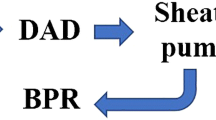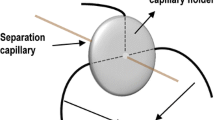Abstract
A low-cost methodology using hollow fiber liquid-phase microextraction (HF-LPME) and capillary zone electrophoresis (CZE) with UV-Vis detector was developed to analyze the salicylic acid (SA) in estuarine and riverine waters. The technique is easy-to-use and rapid, and demands little volume of organic solvent. The extraction was carried out using a polypropylene membrane supporting into octan-1-ol. HF-LPME under optimized conditions (donor solution sample pH 2, acceptor solution pH 14, sample volume 25 mL, fiber length 10 cm, acceptor volume 25 μL, extraction time 3 h and stirring speed 350 rpm) presented high enrichment factor (407 times) and good recovery in real water samples (from 88 to 110%). A limit of detection of 2.6 μg L−1 was achieved using CZE with UV-Vis detector as quantification method. The method was applied to direct quantification of SA in environmental complex estuarine and riverine water matrices.



Similar content being viewed by others
References
Ahmad SM, Almeida C, Neng NR, Nogueira JMF (2016) Bar adsorptive microextraction (BAμE) coated with mixed sorbent phases—enhanced selectivity for the determination of non-steroidal anti-inflammatory drugs in real matrices in combination with capillary electrophoresis. J Chromatogr B 1008:115–124
Asensio-Ramos M, Ravelo-Pérez LM, González-Curbelo MA, Hernández-Borges J (2011) Liquid phase microextraction applications in food analysis. J Chromatogr A 1218:7415–7437
Bairros AV, Almeida RM, Pantaleão L, Barcellos T, Silva SM, Yonamine M (2015) Determination of low levels of benzodiazepines and their metabolites in urine by hollow-fiber liquid-phase microextraction (LPME) and gas chromatography–mass spectrometry (GC–MS). J Chromatogr B 975:24–33
Baranowska I, Kowalski B (2012) A rapid UHPLC method for the simultaneous determination of drugs from different therapeutic groups in surface water and wastewater. Bull Environ Contam Toxicol 89:8–14
Camino-Sánchez FJ, Rodríguez-Gómez R, Zafra-Gómez A, Santos-Fandila A, Vílchez JL (2014) Stir bar sorptive extraction: recent applications, limitations and future trends. Talanta 130:388–399
Cleuvers M (2004) Mixture toxicity of the anti-inflammatory drug diclofenac, ibuprofen, naproxen, and acetylsalicylic acid. Ecotoxicol Environ Saf 59:309–315
Comeau F, Surette C, Brun GL, Losier R (2008) The occurrence of acidic drugs and caffeine in sewage effluents and receiving waters from three coastal watersheds in Atlantic Canada. Sci Total Environ 396:132–146
Es’haghi Z (2011) Extraction and determination of three chlorophenols by hollow fiber liquid phase microextraction - spectrophotometric analysis, and evaluation procedures using mean centering of ratio spectra method. Am J Anal Chem 2:1–8
Gjelstad A, Pedersen-Bjergaard S (2013) Perspective: hollow fibre liquid-phase microextraction principles, performance, applicability, and future directions. Scientia Chromatographica 5:181–189
Gjelstad A, Jensen H, Rasmussen KE, Pedersen-Bjergaard S (2012) Kinetic aspects of hollow fiber liquid-phase microextraction and electromembrane extraction. Analitica Chimica Acta 742:10–16
Han D, Tian M, Ho KH (2012) Ionic liquid as hollow fibre membrane carrier for extraction of fluoroquinolone antibiotics in milk coupled with high-performance liquid chromatography quantification. Int J Environ Anal Chem 92:1036–1045
He Y (2014) Recent advances in application of liquid-based micro-extraction: a review. Chem Pap 68:995–1007
Jing S-J, Li Q-L, Jiang Y (2016) A new simultaneous derivatization and microextration method for the determination of memantine hydrochloride in human plasma. J Chromatogr B 1008:26–31
Li P, He M, Chen B, Hu B (2015) Automated dynamic hollow fiber liquid–liquid–liquid microextraction combined with capillary electrophoresis for speciation of mercury in biological and environmental samples. J Chromatogr A 1415:48–56
Lima DLD, Silva CP, Otero M, Esteves VI (2013) Low cost methodology for estrogens monitoring in water samples using dispersive liquid–liquid microextraction and HPLC with fluorescence detection. Talanta 115:980–985
Lima DLD, Silva CP, Schneider RJ, Otero M, Esteves VI (2014) Application of dispersive liquid-liquid microextraction for estrogens’ quantification by enzyme-linked immunosorbent assay. Talanta 125:102–106
Liu H, Dasgupta PK (1996) Analytical chemistry in a drop. Solvent extraction in a microdrop. Anal Chem 68:1817–1821
Msagati T, Chimuka L, Cukrowska E (2008) Sample preparation using liquid membrane extraction techniques. Water SA 34:421–428
Navarro MV, Payán MR, Fernández-Torres R, Bello-López MA, Mochón MC, Pérez AG (2011) Capillary electrophoresis determination of nonsteroidal anti-inflammatory drugs in wastewater using hollow fiber liquid-phase microextraction. Electrophoresis 32:2107–2113
Olives AI, González-Ruiz V, Martín MA (2012) Isolation and quantitative methods for analysis of non-steroidal anti-inflammatory drugs. Anti-Inflammatory & Anti-Allergy Agents in Medicinal Chemistry 11:65–95
Parhi PK (2013) Supported liquid membrane principle and its practices: a short review. Journal of Chemistry 2013:1–11
Payán MR, López MAB, Fernández-Torres R, Bernal JLP, Mochón MC (2009) HPLC determination of ibuprofen, diclofenac and salicylic acid using hollow fiber-based liquid phase microextraction (HF-LPME). Anal Chim Acta 653:184–190
Payán MR, López MAB, Fernández-Torres R, Mochón MC, Ariza JLG (2010) Application of hollow fiber-based liquid-phase microextraction (HF-LPME) for the determination of acidic pharmaceuticals in wastewaters. Talanta 82:854–858
Penga X, Yua Y, Tanga C, Tana J, Huanga Q, Wang Z (2008) Occurrence of steroid estrogens, endocrine-disrupting phenols, and acid pharmaceutical residues in urban riverine water of the Pearl River Delta, South China. Sci Total Environ 397:158–166
Petrie B, Barden R, Kasprzyk-Hordern B (2015) A review on emerging contaminants in wastewaters and the environment: current knowledge, understudied areas and recommendations for future monitoring. Water Res 72:3–27
Psillakis E, Kalogerakis N (2003) Developments in liquid-phase microextraction. Trends Anal Chem 22:565–574
Rezaee M, Assadi Y, Hosseini MRM, Aghaee E, Ahmadi F, Berijani S (2006) Determination of organic compounds in water using dispersive liquid–liquid microextraction. J Chromatogr A 1116:1–9
Sharifi V, Abbasi A, Nosrati A (2016) Application of hollow fiber liquid phase microextraction and dispersive liquid-liquid microextraction techniques in analytical toxicology. J Food Drug Anal 24:264–276
Spietelun A, Kloskowski A, Chrzanowski W, Namiesnik J (2013) Understanding solid-phase microextraction: key factors influencing the extraction process and trends in improving the technique. Chem Rev 113:1667–1685
Tong F, Zhang Y, Chen F, Li Y, Ma G, Chen Y, Liu K, Dong J, Ye J, Chu Q (2013) Hollow-fiber liquid-phase microextraction combined with capillary electrophoresis for trace analysis of sulfonamide compounds. J Chromatogr B 942–943:134–140
Varga M, Dobor J, Helenkár A, Jurecska L, Yao J, Záray G (2010) Investigation of acidic pharmaceuticals in river water and sediment by microwave-assisted extraction and gas chromatography–mass spectrometry. Microchem J 95:353–358
Wang R, Qi X, Zhao L, Liu S, Gao S, Ma X, Deng Y (2016) Ionic-liquid-based dispersive liquid–liquid microextraction coupled with high-performance liquid chromatography for the forensic determination of methamphetamine in human urine. J Sep Sci 39:2444–2450
Xiong J, Hu B (2008) Comparison of hollow fiber liquid phase microextraction and dispersive liquid–liquid microextraction for the determination of organosulfur pesticides in environmental and beverage samples by gas chromatography with flame photometric detection. J Chromatogr A 1193:7–18
Zeng EY (2015) Persistent organic pollutants (POPs): analytical techniques, environmental fate and biological effects. Compr Anal Chem 67:1–660 ISBN: 978-0-444-63299-9
Zhang PP, Shi ZG, Yu QW, Feng YQ (2011) A new device for magnetic stirring-assisted dispersive liquid–liquid microextraction of UV filters in environmental water samples. Talanta 83:1711–1715
Acknowledgements
Thanks are due for the financial support to CESAM (UID/AMB/50017/2013), to FCT/MEC through national funds, and the co-funding by the FEDER, within the PT2020 Partnership Agreement and Compete 2020. Diana Lima thanks FCT for her postdoctoral grant (SFRH/BPD/80315/2011). Gilmar Silvério da Silva thanks FAPEMA for scholarship and Federal Institute of Education Science and Technology of Maranhão/Campus Monte Castelo.
Author information
Authors and Affiliations
Corresponding author
Additional information
Responsible editor: Ester Heath
Rights and permissions
About this article
Cite this article
da Silva, G.S., Lima, D.L.D. & Esteves, V.I. Salicylic acid determination in estuarine and riverine waters using hollow fiber liquid-phase microextraction and capillary zone electrophoresis. Environ Sci Pollut Res 24, 15748–15755 (2017). https://doi.org/10.1007/s11356-017-9183-2
Received:
Accepted:
Published:
Issue Date:
DOI: https://doi.org/10.1007/s11356-017-9183-2




